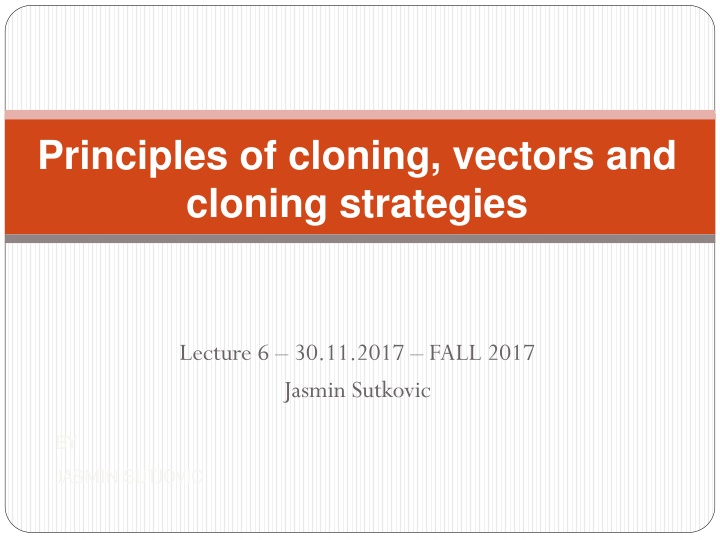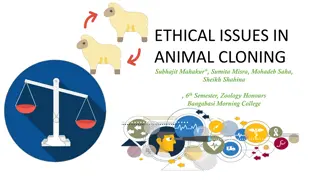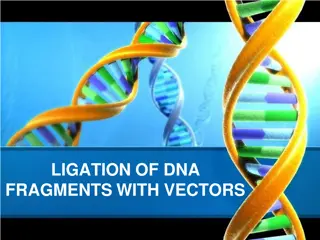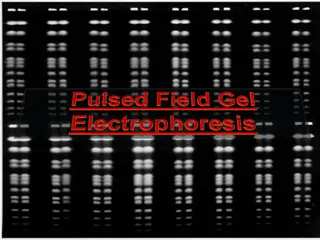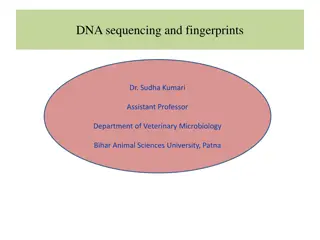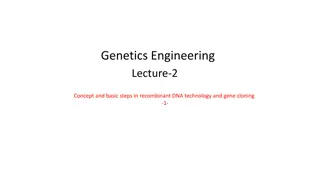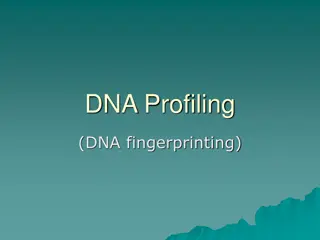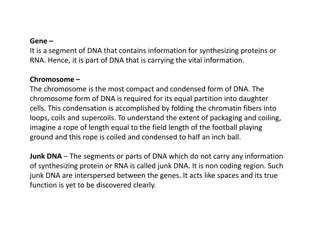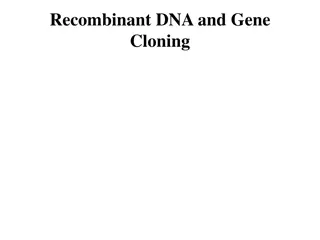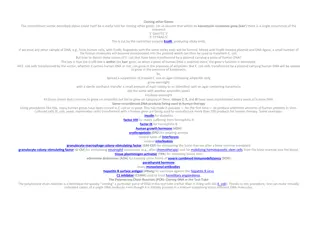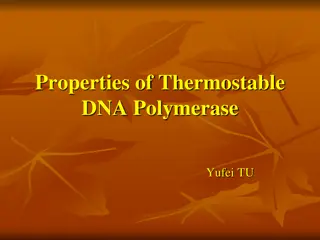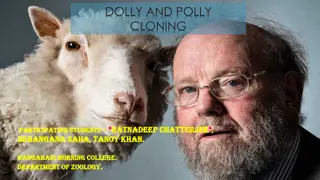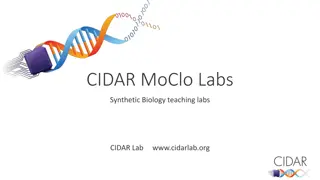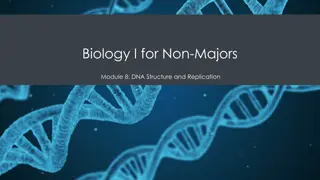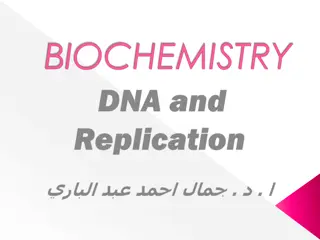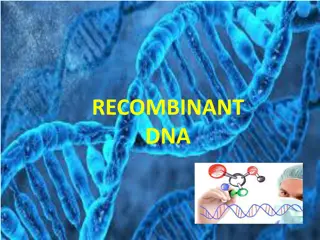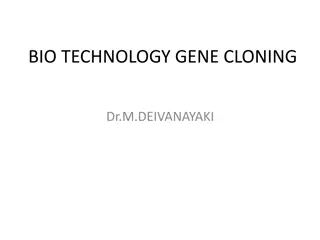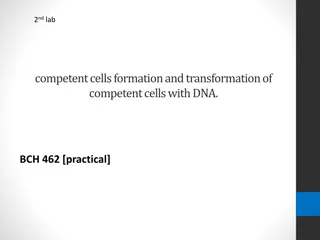Principles of Cloning and DNA Cloning Techniques
The principles of cloning, vectors, and cloning strategies, along with the DNA cloning process and strategies involved. Understand DNA cloning's role in reproducing DNA fragments and its applications in genetic engineering experiments.
Download Presentation

Please find below an Image/Link to download the presentation.
The content on the website is provided AS IS for your information and personal use only. It may not be sold, licensed, or shared on other websites without obtaining consent from the author.If you encounter any issues during the download, it is possible that the publisher has removed the file from their server.
You are allowed to download the files provided on this website for personal or commercial use, subject to the condition that they are used lawfully. All files are the property of their respective owners.
The content on the website is provided AS IS for your information and personal use only. It may not be sold, licensed, or shared on other websites without obtaining consent from the author.
E N D
Presentation Transcript
Principles of cloning, vectors and cloning strategies Lecture 6 30.11.2017 FALL 2017 Jasmin Sutkovic BY JASMIN SUTJOVIC
Principles of cloning, vectors and cloning strategies
DNA CLONING DNA cloning is a technique for reproducing DNA fragments. It can be achieved by two different approaches: cell based using polymerase chain reaction (PCR). a vector is required to carry the DNA fragment of interest into the host cell.
DNA CLONING DNA cloning allows a copy of any specific part of a DNA (or RNA) sequence to be selected among many others and produced in an unlimited amount. This technique is the first stage of most of the genetic engineering experiments: production of DNA libraries PCR DNA sequencing
DNA CLONING Massive amplification of DNA sequences Stable propagation of DNA sequences A single DNA molecule can be amplified allowing it to be: Studied - Sequenced Manipulated - Mutagenised or Engineered Expressed - Generation of Protein
CLONING PROCESS Gene of interest is cut out with RE Host plasmid is cut with same RE Gene is inserted into plasmid and ligated with ligase New plasmid inserted into bacterium(transform)
PLASMID CLONING STRATEGY PLASMID CLONING STRATEGY Involves five steps: 1. Enzyme restriction digest of DNA sample. 2.Enzyme restriction digest of DNA plasmid vector. 3.Ligation of DNA sample products and plasmid vector. 4.Transformation with the ligation products. 5.Growth on agar plates with selection for antibiotic resistance.
STEP 4. TRANSFORMATION OF LIGATION PRODUCTS The process of transferring exogenous DNA into cells is call transformation There are basically two general methods for transforming bacteria. The first is a chemical method utilizing CaCl2 and heat shock to promote DNA entry into cells. A second method is called electroporation based on a short pulse of electric charge to facilitate DNA uptake.
CHEMICAL TRANSFORMATION WITH CALCIUM CHLORIDE
TRANSFORMATION BY TRANSFORMATION BY ELECTROPORATION ELECTROPORATION
STEP 5 Blue colonies represent Ampicillin-resistant bacteria that contain pVector and express a functional alpha fragment from an intact LacZ alpha coding sequence. White colonies represent Ampicillin-resistant bacteria that contain pInsert and do not produce LacZ alpha fragment
TERMS USED IN CLONING DNA recombination. The DNA fragment to be cloned is inserted into a vector. Transformation. The recombinant DNA enters into the host cell and proliferates. Selective amplification. A specific antibiotic is added to kill E. coli without any protection. The transformed E. coli is protected by the antibiotic- resistance gene Isolation of desired DNA clones
CLONING VECTORS Cloning vectors are DNA molecules that are used to "transport" cloned sequences between biological hosts and the test tube. Cloning vectors share four common properties: 1. Ability to promote autonomous replication. 2. Contain a genetic marker (usually dominant) for selection. 3. Unique restriction sites to facilitate cloning of insert DNA. 4. Minimum amount of nonessential DNA to optimize cloning.
PLASMIDS Bacterial cells may contain extra- chromosomal DNA called plasmids. Plasmids are usually represented by small, circular DNA. Some plasmids are present in multiple copies in the cell
PLASMID VECTORS Plasmid vectors are 1.2 3kb and contain: replication origin (ORI) sequence a gene that permits selection, Here the selective gene is ampr; it encodes the enzyme b-lactamase, which inactivates ampicillin. Exogenous DNA can be inserted into the bracketed region .
SELECTIVE MARKER Selective marker is required for maintenance of plasmid in the cell. Because of the presence of the selective marker the plasmid becomes useful for the cell. Under the selective conditions, only cells that contain plasmids with selectable marker can survive Genes that confer resistance to various antibiotics are used. Genes that make cells resistant to ampicillin, neomycin, or chloramphenicol are used
ORIGIN OF REPLICATION Origin of replication is a DNA segment recognized by the cellular DNA-replication enzymes. Without replication origin, DNA cannot be replicated in the cell.
MULTIPLE CLONING SITE Many cloning vectors contain a multiple cloning site or polylinker: a DNA segment with several unique sites for restriction endo- nucleases located next to each other Restriction sites of the polylinker are not present anywhere else in the plasmid. Cutting plasmids with one of the restriction enzymes that recognize a site in the polylinker does not disrupt any of the essential features of the vector
MULTIPLE CLONING SITE Gene to be cloned can be introduced into the cloning vector at one of the restriction sites present in the polylinker
CLONING VECTORS Different types of cloning vectors are used for different types of cloning experiments. The vector is chosen according to the size and type of DNA to be cloned.
PLASMID VECTORS Plasmid vectors are used to clone DNA ranging in size from several base pairs to several thousands of base pairs (100bp -15kb). ColE1 based, pUC vehicles commercially available ones, eg pGEM3, pBlueScript
Disadvantages using plasmids Cannot accept large fragments Sizes range from 0- 10 kb (usually) Standard methods of transformation are inefficient
BACTERIOPHAGE LAMBDA Phage lambda is a bacteriophage or phage, i.e. bacterial virus, that uses E. coli as host. Its structure is that of a typical phage: head, tail, tail fibres. Lambda viral genome: 48.5 kb linear DNA with a 12 base ssDNA "sticky end" at both ends; these ends are complementary in sequence and can hybridize to each other (this is the cos site: cohesive ends). Infection: lambda tail fibres adsorb to a cell surface receptor, the tail contracts, and the DNA is injected. The DNA circularizes at the cos site, and lambda begins its life cycle in the E. coli host.
COSMID VECTOR Purpose: 1. Clone large inserts of DNA: size ~ 45 kb Features: Cosmids are Plasmids with one or two Lambda Cos sites. Presence of the Cos site permits in vitro packaging of cosmid DNA into Lambda particles
COSMID VECTOR Thus, have some advantages of Lambda as Cloning Vehicle: Strong selection for cloning of large inserts Infection process rather than transformation for entry of chimeric DNA into E. coli host Maintain Cosmids as phage particles in solution But Cosmids are Plasmids: Thus do NOT form plaques but rather cloning proceeds via E. coli colony formation
Yeast Artificial Chromosomes Yeast Artificial Chromosomes
Yeast Artificial Chromosomes Purpose: Cloning vehicles that propogate in eukaryotic cell hosts as eukaryotic Chromosomes Clone very large inserts of DNA: 100 kb - 10 Mb Features: YAC cloning vehicles are plasmids Final chimeric DNA is a linear DNA molecule with telomeric ends: Artificial Chromosome
Additional features: Often have a selection for an insert YAC cloning vehicles often have a bacterial origin of DNA replication (ori) and a selection marker for propogation of the YAC through bacteria. The YAC can use both yeast and bacteria as a host
RETROVIRAL VECTORS Retroviral vectors are used to introduce new or altered genes into the genomes of human and animal cells. Retroviruses are RNA viruses. The viral RNA is converted into DNA by the viral reverse transcriptase and then is efficiently integrated into the host genome Any foreign or mutated host gene introduced into the retroviral genome will be integrated into the host chromosome and can reside there practically indefinitely. Retroviral vectors are widely used to study oncogenes and other human genes.
CLONING STRATEGY Strategy depends on the starting information and desired endpoint. Starting Information or Resources: Protein sequence Positional cloning information mRNA species / sequence cDNA libraries DNA sequence known or unknown genomic DNA libraries PCR product
How Are Genes Cloned Using How Are Genes Cloned Using Plasmids? Plasmids? To understand how genes are cloned, we need introduce three terms. Recombinant DNA- is mixed DNA Vector -it carries recombinant DNA into cells. Plasmids - are tiny circular pieces of DNA that are commonly found in bacteria.
Why Plasmids are Good Cloning Vectors small size (easy to manipulate and isolate) circular (more stable) replication independent of host cell several copies may be present (facilitates replication) frequently have antibody resistance (detection easy)
How is foreign DNA Inserted into a How is foreign DNA Inserted into a Plasmid? Plasmid? To open up the DNA a restriction enzyme is used. Cut the DNA at a specific place called a restriction site. The result is a set of double-stranded DNA pieces with single-stranded ends These ends that jut out are not only "sticky" but they have gaps that can be now be filled with a piece of foreign DNA For DNA from an outside source to bond with an original fragment, one more enzyme is needed DNA ligase seals any breaks in the DNA molecule
RESTRICTION ENZYMES Restriction enzymes: enzymes that cut DNA in specific places function: Inactivate foreign DNA Breaks only palindrome sequences, i.e. those exhibiting two-fold symmetry Important in DNA research, i.e. sequencing, hybridization Companies purify and market restriction enzymes
CLONING METHODOLOGY Cut the cloning vector with R.E. of choice, eg Eco RI Cut DNA of interest with same R.E. or R.E. yielding same sticky ends, e.g. Bam HI and Sau 3A Mix the restricted cloning vector and DNA of interest together. Ligate fragments together using DNA ligase Insert ligated DNA into host of choice - transformation of E. coli Grow host cells under restrictive conditions, grow on plates containing an antibiotic
Video 1 https://www.youtube.com/watch?v=0iwWCFG4fHs
Video 2 https://www.youtube.com/watch?v=piGOuud3f40
